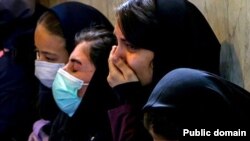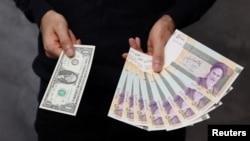
Welcome back to The Farda Briefing, an RFE/RL newsletter that tracks the key issues in Iran and explains why they matter. To subscribe, click here.
I'm RFE/RL correspondent Golnaz Esfandiari. Here's what I've been following during the past week and what I'm watching for in the days ahead.
The Big Issue
Several thousand schoolgirls have reportedly fallen sick in Iran in recent months amid claims by some officials that they were poisoned.
The authorities appeared to ignore reports of suspected poisonings that first emerged in November. But they have come under mounting public pressure to respond amid a surge in cases in recent weeks.
On March 7, the authorities announced the arrest of five people allegedly involved in the suspected poisonings. The arrests came a day after Supreme Leader Ayatollah Ali Khamenei said that “if the poisoning of students is proven, those behind this crime should be sentenced to [death].”
Iran’s Health Ministry said on March 7 that around 10 percent of the affected students had been exposed to an unknown substance, without elaborating. The ministry attributed the vast majority of cases to “anxiety.”
Why It Matters: The suspected poisonings are the newest crisis to confront Iran’s clerical regime, which is already reeling from months of anti-government protests that erupted in September. There have also been recent demonstrations over rising inflation and the worsening economy.
The public backlash against the government over its handling of the suspected poisonings has also highlighted the deep mistrust of the regime. Some Iranians have accused the authorities of orchestrating the poisonings as an act of revenge against girls for participating in the antiestablishment protests, a claim rejected by the government.
What's Next: Angry teachers and parents have staged protests in a number of cities in recent days, including Tehran, Karaj, Mashhad, Gilan, and Saghez. Security forces dispersed the rallies by using water cannons and tear gas.
The authorities’ failure to conduct a transparent investigation and determine the cause of the illnesses could fuel further protests.
Stories You Might Have Missed
Several Iranian civil and political activists who were recently released from prison by an amnesty decree have been summoned again. Photojournalist Alieh Motalebzadeh said she has been summoned twice by judicial officials since her release from prison, in a sign of how authorities continue to pressure her and other civil activists. On February 5, Khamenei issued an amnesty for "tens of thousands" of prisoners, including protesters arrested during the anti-regime rallies.
Iranian journalist Keyvan Samimi, who was recently released from prison, says anti-regime protests, which have subsided in recent weeks, are likely to surge again. In an interview with RFE/RL's Radio Farda, Samimi said protesters will not be satisfied until there is real change. “The protests are not over and are quite likely to rise again if something unexpected happens,” the 73-year-old Samimi said.
What We're Watching
Rafael Grossi, the head of the International Atomic Energy Agency (IAEA), said on March 4 that Iran had promised to restore cameras at its nuclear facilities and allow inspections of three undeclared nuclear sites where traces of uranium particles had been found.
But a joint statement later issued by the IAEA and Iran's Atomic Energy Organization (AEOI) only included vague pledges by Tehran. AEOI spokesman Behruz Kamalvandi later denied that Tehran had pledged to reinstall IAEA cameras that Iran removed last year.
On March 6, Grossi conceded that any concessions by Iran to the IAEA largely depend on future talks.
Why It Matters: The vague joint statement appears to have been enough to prevent another resolution by the West condemning Iran.
In June, the IAEA adopted a resolution submitted by the West that criticized Tehran for failing to fully cooperate with the body. The censure angered Tehran, which warned of retaliation.
That's all from me for now. Don't forget to send me any questions, comments, or tips that you have.
Until next time,
Golnaz Esfandiari
If you enjoyed this briefing and don't want to miss the next edition, subscribe here. It will be sent to your inbox every Wednesday.





